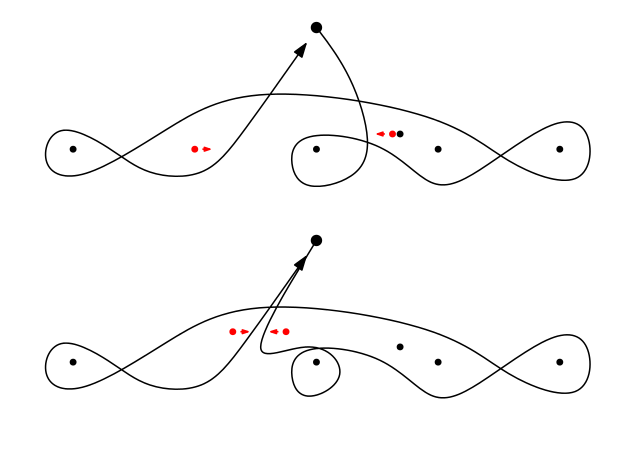The short answer is yes. I will try to explain the intuition behind appearance of the reduced free groups and the link homotopy and why they are related; for the rest, I refer to the great papers of Milnor, Goldsmith, Habegger&Lin and Bar-Natan.
Pure braids which are allowed to go ''back in time'' were given a name by Habegger and Lin: an $n$-component string link $\sigma$ is a proper embedding of $n$ intervals (strings) into the cylindar $\mathbb{D}^2\times I$ so that $i$-th string starts and ends at the prescribed point $p_i\in\mathbb{D}^2$.
As already mentioned, if $\sigma$ is actually a pure braid, then we can look at the induced automorphism $\xi_\sigma$ of the free group $\mathbb{F}\langle x_1,\dots,x_n\rangle=\pi_1(\mathbb{D}^2_n,*)$; here we denote $\mathbb{D}^2_n:=\mathbb{D}^2\setminus\{p_1,\dots,p_n\}$ and each generator $x_i$ corresponds to a small loop around the single puncture $p_i$, plus an arc to the basepoint. Geometrically $\xi_\sigma$ is described by noticing that the complement $\mathbb{D}^2\times I \setminus\sigma$ deformation retracts onto both ends $\mathbb{D}^2_n\times \{0\}$ and $\mathbb{D}^2_n\times \{1\}$, inducing an isomorphism on their fundamental groups. One can actually use Wirtinger presentation for the complement of the braid to write down an algorithm which determines $\xi_\sigma(x_i)$ for each generator $x_i\in\pi_1(\mathbb{D}^2_n\times \{0\},*)$.
That goes roughly as follows. Drag the meridinal loop $x_i$ upwards along $i$-th strand and the first time it passes an undercrossing in the braid diagram (assuming we chose the basepoint ''above the projection plane''), transform the meridian $x_i$ according to a Wirtinger-type move:
$$
x_i\mapsto \alpha y_i\alpha^{-1}:=y_i^\alpha
$$
where $\alpha$ is the meridian corresponding to the overcrossing arc and $y_i$ is the new meridian of the $i$-th strand after the crossing. Now drag $\alpha$ and $y_i$ upwards in the same manner; moreover, repeat with all other meridians to arcs that show up on the way, until you get a word only in the meridians to the upmost arcs. This word is $\xi_\sigma(x_i)$.
However, the group $\pi_1(\mathbb{D}^2\times I \setminus\sigma)$ for a more general string link is not isomorphic to the free group. Whenever a ''reversal in time'' happens, we are forced to drag our meridian down, so some undercrossing on our way might force us to conjugate by something we already had before. For example, for the string link in Jjm's post (read it from right to left) we get $x_4\mapsto y_4^\alpha$ and $y_4\mapsto z_4^{x_4}$, so we can't terminate the procedure!
One way to get around this is to notice that problems arise when we are trying to conjugate by an element which is already a conjugate of the meridian for the same strand. Hence, if we now imagine that we are always allowed to change a crossing of a strand with itself, this problem will dissapear: we are introducing relations that any two conjugates of $x_i$ commute with each other.
Definition. [Milnor] For any group G normally generated by some elements $a_1,\dots,a_k$ define $\mathbb{R}G$ as the quotient of $G$ by relations that impose that each $a_i$ commutes with any of its conjugates. For example, we have the reduced free group $\mathbb{RF}_n:=\mathbb{F}_n\big/\langle [x_i,x_i^\alpha]=1, \forall \alpha \rangle$.
From this perspecitve it is natural to introduce the relation of link homotopy on string links: the homotopy of the strings relative to their boundary, such that distinct strings remain disjoint at all times. One can show that the set of equivalence classes, called homotopy string links, forms a group $\mathcal{H}_n$ with respect to the concatenation. Moreover, we now have the isomorphism of reduced groups $\mathbb{R}\pi_1(\mathbb{D}^2\times I \setminus\sigma)\cong \mathbb{RF}_n$ and every homotopy string link induces an automorphism of $\mathbb{RF}_n$ analogous to $\xi_\sigma$ above. Habegger and Lin give a characterization of these autuomorphisms analogous to the Artin's presentation.
One of the most useful tools when dealing with these groups is the existence of (split) short exact sequences:
$\require{AMScd}$
\begin{CD}
0@>>> \mathbb{F}_n @>>> P\mathcal{B}_n @>{\text{forget last strand}}>> P\mathcal{B}_{n-1} @>>> 0\\
@. @VVV @V{h}VV @VVV \\
0@>>> \mathbb{RF}_n @>>> \mathcal{H}_n @>{\text{forget last strand}}>> \mathcal{H}_{n-1} @>>> 0
\end{CD}
where the map $h$ is just the quotient by the link homotopy. Using them one shows that: one can comb a pure braid, one cam comb a string link, any string link is link-homotopic to a pure braid (i.e. $h$ is onto) and the kernel of $h$ (first described by Goldsmith) is normally generated by pure braids $[A_{jk},A_{jk}^g]$, for $g\in \mathbb{F}\langle A_{1k},\dots,A_{k-1k}\rangle$.
- J. Milnor, Link groups, Ann. of Math. 59 (1954),177-195.
- D. Goldsmith, Homotopy of links: in answer to a question of E. Artin, Topology Conference, Lecture Notes in Math., vol 357, Springer-Verlag, Berlin, Heidelberg (1974), pp. 91-96.
- N. Habegger and X. Lin, The classification of links up to link-homotopy, J. Amer. Math. Soc. 3 (1990), no. 2, 389–419
- D. Bar-Natan, Vassiliev homotopy string link invariants, Journal of Knot Theory and its Ramifications (1995), 4(01), pp.13-32.




